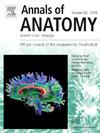添加橄榄磨废渣提取物多酚后生长仔猪胃和十二指肠内脏脂肪素的形态学数字评估和转录本。
IF 2
3区 医学
Q2 ANATOMY & MORPHOLOGY
引用次数: 0
摘要
Visfatin是一种具有炎症调节作用的脂肪因子。它在猪胃中表达水平较低,但其在胃肠道中的作用尚不清楚。本研究探讨了饲喂不同水平橄榄磨废渣提取物多酚(具有抗氧化和免疫调节特性)的仔猪胃和十二指肠中内脏脂肪素的表达和定位。将27头仔猪分为3个饲粮组:对照组(商品饲料)、低多酚组(120 ppm)和高多酚组(240 ppm)。饲喂14 d后,取13头仔猪腺胃和十二指肠标本。采用免疫组织化学(IHC)、QuPath软件的数字图像分析(DIA)和双标记免疫荧光检测visfatin阳性细胞,并将其与血清素共定位。此外,通过RT-qPCR评估visfatin的相对基因表达。13头仔猪中有5头检测到visfatin阳性细胞,主要分布在胃腺和肠腺的基底部。这些细胞的形态与神经内分泌细胞一致,并通过visfatin和5 -羟色胺的共定位证实。各组间或组织间细胞阳性或形态无显著差异。然而,内脏脂肪素转录物水平随着多酚提取物剂量的增加而增加。这些发现表明,膳食多酚可能调节胃肠道内内脏脂肪素基因的表达。该研究还强调了数字解剖学在提高解剖学研究的准确性和可重复性方面的价值。visfatin转录本和蛋白在猪胃肠道中的功能作用有待进一步研究。本文章由计算机程序翻译,如有差异,请以英文原文为准。
Morphological digital assessment and transcripts of gastric and duodenal visfatin in growing piglets fed with increasing amounts of polyphenols from olive mill waste extract
Visfatin is an adipokine with mediatory effects on inflammation. It is expressed at low levels in the pig stomach, but its role in the gastrointestinal (GI) tract is not well understood. This study explored visfatin expression and localisation in the stomach and duodenum of piglets fed varying levels of polyphenols derived from olive mill waste extract, known for their antioxidant and immunomodulatory properties. Twenty-seven piglets were assigned to three dietary groups: control (commercial feed), low polyphenol (120 ppm), and high polyphenol (240 ppm) groups. After 14 days of feeding, samples from the glandular stomach and duodenum were collected from 13 piglets. Immunohistochemistry (IHC), digital image analysis (DIA) using QuPath software, and double-labelled immunofluorescence were performed to detect visfatin-positive cells and co-localise them with serotonin. Additionally, relative gene expression of visfatin was assessed via RT-qPCR. Visfatin-positive cells were identified in 5 out of 13 piglets, localised mainly in the basal portion of gastric and intestinal glands. The morphology of those cells was consistent with neuroendocrine cells and confirmed by co-localisation of visfatin and serotonin. No significant differences were found in cell positivity or morphology between dietary groups or between tissues. However, visfatin transcript levels increased with the dose of polyphenolic extract. These findings suggest that dietary polyphenols may modulate visfatin gene expression in the GI tract. The study also highlights the value of digital anatomy for enhancing the accuracy and reproducibility of anatomical research. Further studies are needed to elucidate the functional role of visfatin transcript and protein in the porcine GI tract.
求助全文
通过发布文献求助,成功后即可免费获取论文全文。
去求助
来源期刊

Annals of Anatomy-Anatomischer Anzeiger
医学-解剖学与形态学
CiteScore
4.40
自引率
22.70%
发文量
137
审稿时长
33 days
期刊介绍:
Annals of Anatomy publish peer reviewed original articles as well as brief review articles. The journal is open to original papers covering a link between anatomy and areas such as
•molecular biology,
•cell biology
•reproductive biology
•immunobiology
•developmental biology, neurobiology
•embryology as well as
•neuroanatomy
•neuroimmunology
•clinical anatomy
•comparative anatomy
•modern imaging techniques
•evolution, and especially also
•aging
 求助内容:
求助内容: 应助结果提醒方式:
应助结果提醒方式:


